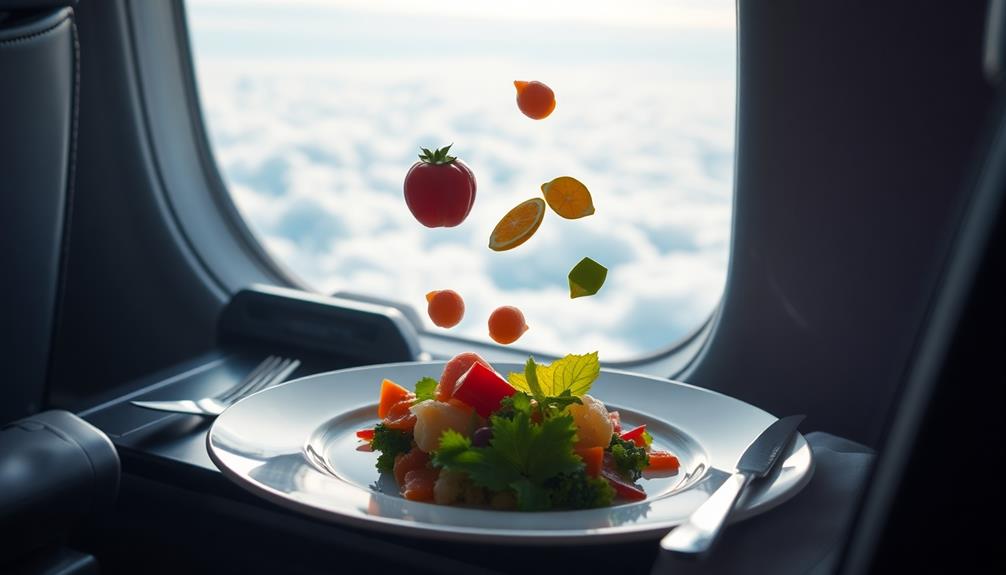Air travel can seriously mess with your taste buds. At cruising altitudes, your sensitivity to sweet and salty flavors drops by about 30%. Low humidity and pressure make food taste bland, almost like you're eating cardboard. Plus, the noisy cabin environment enhances umami flavors while dulling others, reshaping your dining experience. You might notice that airlines are tweaking meal preparations to counteract these effects, focusing on hearty umami-rich dishes. Even the cutlery you use can enhance or dampen flavor perception. Curious about how airlines are working to improve your in-flight meal experience? There's more to discover!
Key Takeaways
- Cruising at 30,000 feet reduces the sensitivity to sweet and salty flavors by about 30%, altering taste perception significantly.
- Low humidity levels in aircraft impair the ability to detect aromas, making flavorful dishes taste bland.
- Background noise can enhance umami flavors while diminishing sweetness and saltiness, affecting overall meal enjoyment.
- Heavy metal cutlery improves flavor perception compared to lightweight plastic utensils, enhancing the dining experience.
- Wine selection for flights favors robust flavors like Grenache and Syrah to combat altitude-related taste changes.
High Altitude and Taste Sensitivity
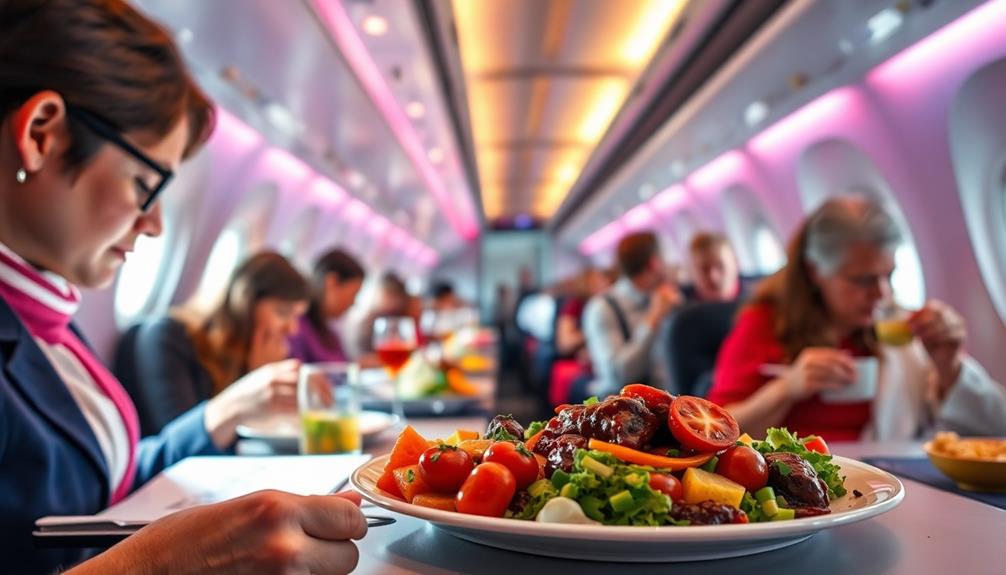
At cruising altitudes, the experience of dining in the sky is considerably altered due to changes in taste sensitivity. When you're soaring at about 30,000 feet, your sensitivity to sweet and salty foods can drop by roughly 30%. This happens because of the lower atmospheric pressure and humidity levels that often fall below 12%.
The dry air in the cabin, drier than most deserts, affects your olfactory system, making your in-flight meals taste nearly twice as bland as they'd on the ground. Curiously, just as holiday-themed snacks like Graveyard Taco Dip can enhance festive gatherings, the unique challenges of altitude necessitate creative meal adjustments in aviation.
Additionally, background noise levels in aircraft cabins can reach up to 85 decibels. This noise not only drowns out sounds but also diminishes the intensity of sweet and salty flavors, while umami flavors may become more pronounced.
While sweet and salty tastes suffer, sour, bitter, and spicy flavors largely remain unchanged, prompting airlines to adjust meal preparations to cater to these shifts. You might also notice that drinks, like wines, taste thinner and more acidic due to expansion and contraction at high altitudes.
All these factors combine to create unique flavor experiences that are vastly different from dining at sea level.
Flavor Perception at High Altitudes

Flying high above the ground changes how you perceive flavors, leading to a unique dining experience that can be surprising. At cruising altitudes around 30,000 feet, your taste buds' sensitivity to sweetness and saltiness diminishes by about 30%. The lower atmospheric pressure and humidity levels below 12% contribute to this shift in flavor perception.
As you sip your drink or enjoy a meal, you might notice that sweet and salty flavors aren't as pronounced, making your food taste blander than it would on the ground. This can be particularly noticeable when enjoying dishes that rely on these flavors, such as the rich flavors of Red-Braised Pork Belly.
Interestingly, while those flavors fade, umami shines through. The background noise in airplane cabins can reach up to 85 decibels, which tends to enhance savory tastes. Meanwhile, sour, bitter, and spicy flavors remain largely unaffected, offering a different experience that you might find intriguing.
Additionally, the dry cabin air can impact your ability to detect aromas, making everything feel a bit more muted. If you're sipping wine or another beverage, expect it to taste thinner and more acidic than usual, due to the expansion and contraction of its components.
This unique blend of factors creates an unexpected culinary adventure at altitude.
The Role of Smell in Dining

Flavor enjoyment hinges on our sense of smell, which plays an essential role in how we perceive food and beverages. When you dine, the aromas wafting from your meal greatly enhance your flavor perception.
For instance, dishes like Nettle and Potato Soup rely heavily on their aromatic ingredients to create a satisfying experience. However, at cruising altitude, the humidity in aircraft cabins drops below 12%, making it harder for your olfactory system to detect those critical aromas. This dampened sense of smell can lead to a bland tasting experience, impacting your overall enjoyment of the meal.
Here are some key factors that affect your dining experience:
- Humidity: Low humidity levels impair your ability to smell, diminishing flavor perception.
- Aroma: Strong aromas are essential for enhancing taste; reduced smell means reduced enjoyment.
- Taste Perception: With hindered smell, even the most flavorful dishes can taste nearly twice as bland.
- Dining Environment: The aircraft cabin's conditions can greatly alter your meal expectations.
Understanding how smell influences taste perception is important, especially when flying. By recognizing this interplay, you can better prepare for what to expect during your airborne dining experiences.
Challenges in Airline Meal Preparation
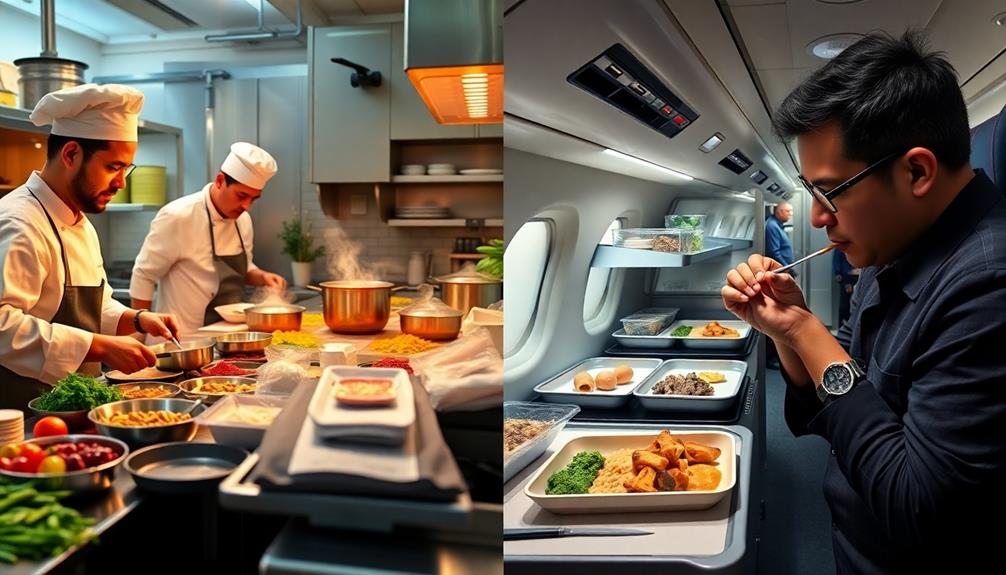
When it comes to airline meal preparation, you're facing significant challenges in both preservation techniques and flavor consistency.
Meals are often mass-produced and blast-chilled, which can compromise freshness and dull the taste. This is particularly unfortunate, as the rich and diverse flavors found in traditional Brazilian cuisine, such as Caldeirada, could provide a much more vibrant dining experience.
As a passenger, you might notice that these factors lead to an overall bland dining experience at 30,000 feet.
Meal Preservation Techniques
In the world of airline meals, preparing food that meets safety standards while maintaining taste is a significant challenge. Airline meals must be cooked, packaged, and chilled on the ground to guarantee food safety. This preservation process often compromises freshness and flavor, especially when coupled with reheating meals in convection ovens during flights.
The high-altitude environment can further alter taste and texture, making it difficult to deliver a satisfying in-flight dining experience. For instance, the delicate flavors of traditional dishes like Dorayaki (Red Bean Pancake) mightn't translate well when subjected to these preservation techniques.
To tackle these challenges, airlines rely on various meal preservation techniques, including:
- Blast-chilling: Rapid cooling to prevent bacterial growth but can affect flavor.
- Refrigeration: Essential for safety, yet it may diminish the meal's freshness.
- Mass production: Streamlines operations but complicates flavor consistency.
- Simulated flight testing: Helps chefs adapt recipes for altitude-related changes.
Collaboration with catering companies is crucial for airline chefs to guarantee that flavor quality is maintained despite these hurdles.
Flavor Consistency Challenges
Achieving consistent flavor in airline meals poses a unique challenge for chefs and catering companies alike. When meals are prepared in bulk, it's tough to maintain flavor consistency for thousands of passengers. The mass production process often results in sacrifices in taste, especially since meals must undergo blast-chilling, refrigeration, and reheating for safety and quality reasons.
These steps can negatively affect freshness and flavor, leaving you with a less-than-satisfying dining experience. For instance, dishes like Mushroom Masala that rely heavily on spice blends can lose their intended depth of flavor when subjected to these processes.
To combat these issues, airlines are increasingly turning to sous-vide cooking methods. This technique allows chefs to prepare meals that retain their ideal flavor during transport, even when produced in large quantities.
However, replicating in-flight conditions is essential for ensuring that the flavors hold up during the flight. Collaboration with catering companies and research facilities is vital to test meals before serving, guaranteeing that you enjoy a meal that tastes as intended.
Despite these efforts, the challenges of bulk preparation and preservation can still lead to variable flavor experiences. Airlines continue to innovate, working to deliver airline meals that delight your taste buds, even at 30,000 feet.
Innovations in In-Flight Dining
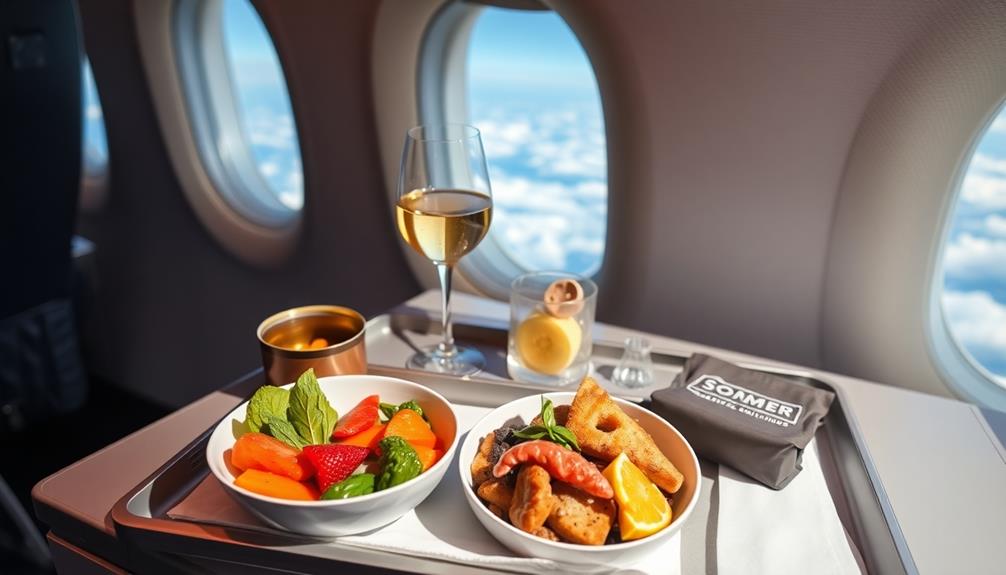
When you board a plane, you might be surprised by the culinary innovations in in-flight dining. Airlines are now using flavor optimization research and advanced cooking techniques to guarantee your meal tastes great at high altitudes.
This is particularly important as the change in pressure and humidity can dull our taste buds, making it harder to enjoy food. For example, many airlines are incorporating classic American comfort foods into their menus to evoke familiar flavors and enhance the dining experience.
Plus, sensory enhancements like music can transform your dining experience, making every bite more enjoyable.
Flavor Optimization Research Methods
Airlines are revolutionizing the in-flight dining experience by employing advanced flavor optimization research methods. By utilizing specialized research facilities, they simulate in-flight conditions to test and enhance meal flavors before serving them to you.
These techniques focus on how different cooking methods and ingredients perform under air pressure, ensuring that your taste senses are satisfied at high altitudes. For instance, dishes like Agnolotti can be optimized for flavor retention, showcasing how traditional stuffed pasta can adapt to the unique challenges of in-flight dining.
Key aspects of flavor optimization include:
- Testing meals in pressurized environments to assess flavor retention.
- Developing umami-rich dishes tailored for enhanced taste perception during flights.
- Exploring soundtracks that complement meals, enhancing your overall dining experience.
- Collaborating with catering companies to maintain consistency and quality in in-flight meals.
These innovations address the unique challenges of in-flight dining, allowing airlines to serve meals that not only fit your palate but also stand up to the rigors of altitude.
As a result, you can expect a more flavorful and enjoyable experience the next time you take to the skies. With ongoing research, the future of in-flight dining looks promising, ensuring your taste buds are well taken care of, even at 30,000 feet.
Culinary Techniques Adaptation
Building on the advancements in flavor optimization, culinary techniques are rapidly evolving to meet the unique demands of in-flight dining. Airline chefs are increasingly adopting sous-vide cooking methods to enhance flavor retention during transport, guaranteeing that every meal is consistent and satisfying for large passenger numbers.
For instance, elements from traditional dishes like Chilaquiles might inspire chefs to incorporate bold flavors and textures, which can be essential for high-altitude dining experiences. Research facilities now simulate in-flight conditions, allowing chefs to adapt recipes specifically for high-altitude taste changes.
Chefs focus on umami-rich ingredients and stronger flavor profiles, as studies show savory dishes are perceived better than sweet ones at altitude. This culinary techniques adaptation helps counteract the diminished taste sensitivity you might experience during your flight.
Innovations in testing meals under pressurized conditions are becoming standard practice, enabling airlines to refine their offerings based on scientific studies of flavor perception at altitude.
As airlines endeavor to elevate your experience, they're not just stopping at food. For example, British Airways has introduced soundtracks paired with meals, using noise-cancelling headphones to enhance the overall dining adventure.
These developments in airline food guarantee that even at 30,000 feet, you can enjoy a delicious and memorable meal.
Sensory Experience Enhancements
Elevating your in-flight dining experience goes beyond just the food on your tray. Airline companies are revolutionizing the way you enjoy meals at 30,000 feet by enhancing your sensory experience.
They're recognizing that your sense of taste can be considerably altered in-flight, and they're adapting accordingly. For instance, the use of umami-rich ingredients can be likened to the rich flavors found in Indonesian dishes like Nasi Tumpeng, which showcases a harmonious blend of tastes.
Here are some key innovations shaping your in-flight experience:
- Simulated cabin conditions: Airlines test meals to optimize flavors and guarantee umami-rich ingredients shine.
- Soundtrack pairing: British Airways uses music and noise-cancelling headphones to align sounds with food flavors, enhancing overall enjoyment.
- Sous-vide cooking: This technique preserves savory tastes during transport, tackling the challenges of mass production and reheating.
- Collaboration with chefs: Airlines work with culinary experts to craft unique recipes that cater to your altered taste perceptions.
Enhancing Flavor Through Sensory Experience
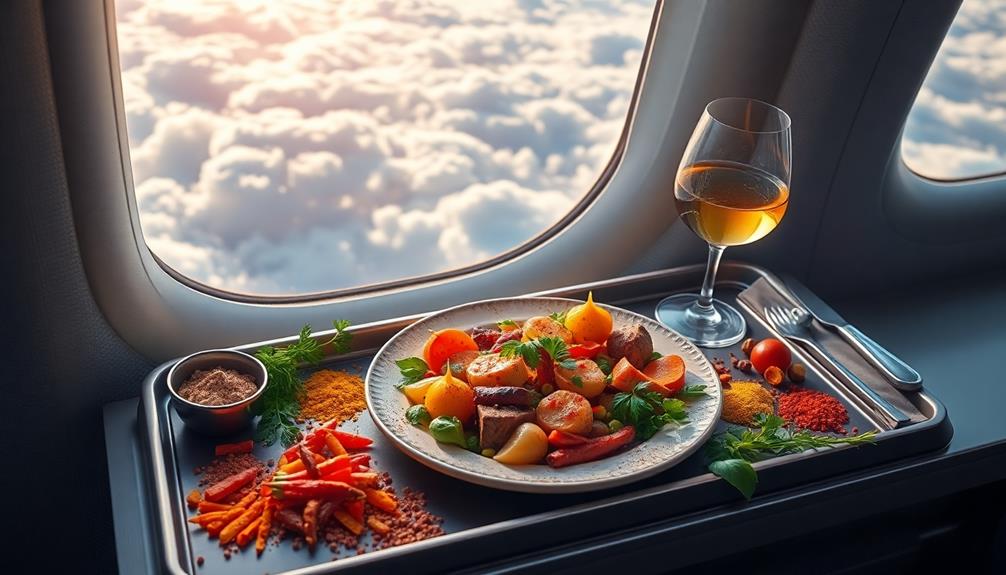
The sensory experience of dining at high altitudes can transform the way you perceive flavors, making in-flight meals surprisingly enjoyable. At cruising altitude, your taste buds respond differently, with certain flavors, like savory tastes, becoming more pronounced.
Research shows that spices such as cardamom and curry deliver a more intense flavor, enhancing the overall dining experience. Umami-rich ingredients, like spinach and shellfish, are especially favored, as they shine in the pressurized cabin environment.
Interestingly, your sense of smell also plays an essential role. The aromas of in-flight meals can greatly enhance flavors, leading to a more satisfying experience. You might find that tomato juice and Bloody Marys taste exceptionally good due to their umami richness, which is heightened at altitude.
Additionally, sound can greatly influence taste perception. Some airlines now use curated soundtracks or noise-canceling headphones to help you enjoy your meal even more.
Effects of Cutlery on Taste
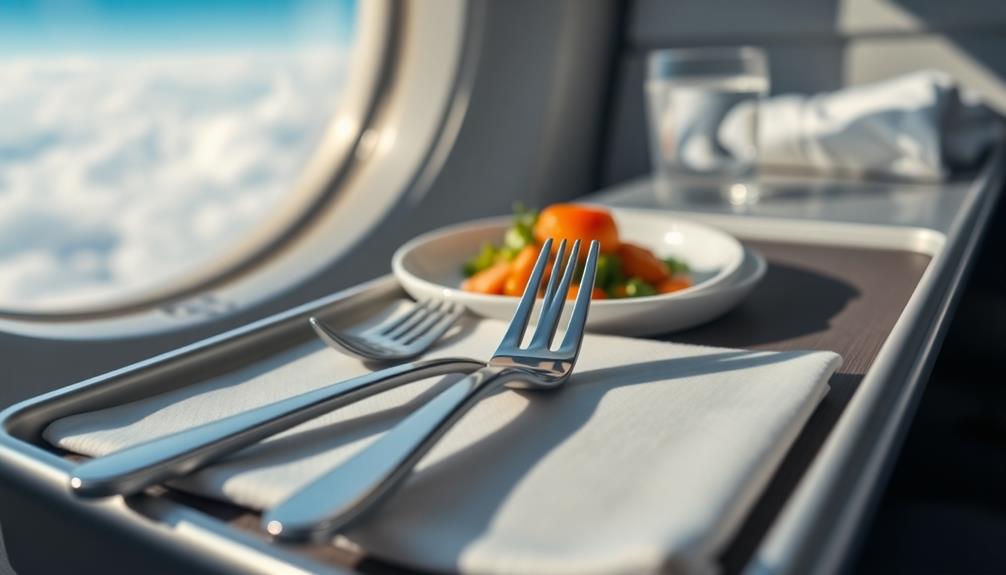
Dining at high altitudes isn't just about the food itself; the utensils you use can greatly enhance your flavor experience. Research shows that heavy cutlery can markedly boost flavor perception compared to light plastic utensils. When you enjoy a meal in the sky, the type of cutlery can transform your dining experience.
Consider how the right cutlery affects your meal:
- Weight: Heavy cutlery gives a more substantial feel, enhancing your enjoyment.
- Material: Metal utensils, as opposed to plastic, elevate the perception of quality.
- Design: Thoughtfully designed cutlery can impact your emotional connection to the meal.
- Overall Experience: Quality materials lead to higher passenger satisfaction and a better overall dining experience.
Airlines recognize that by investing in quality utensils, they can improve your meal enjoyment.
Attention to detail in cutlery design and materials isn't just a luxury; it's essential for enhancing flavor perception.
Wine Selection for Air Travel
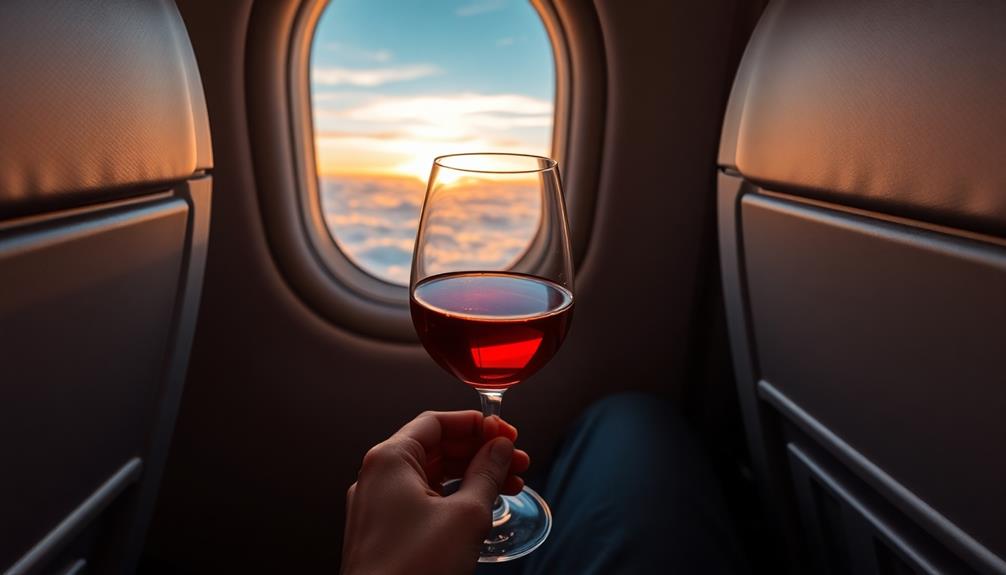
When it comes to choosing wine for your flight, understanding how altitude affects your palate is essential. At high altitudes, your taste perception changes, making certain wines less enjoyable. Fruity wines may lose their character, so it's best to opt for selections with low acidity and low tannin.
Here's a quick reference table for your in-flight wine choices:
| Wine Type | Characteristics |
|---|---|
| Grenache | Soft, fruity, low tannin |
| Syrah | Rich, balanced flavors |
| Zinfandel | Jammy, smooth, low acidity |
| Soft Chardonnay | Creamy, pairs well with umami |
Research shows that airlines now hire sommeliers to curate wine lists tailored for the unique sensory environment of flights. Avoid high-acidity wines like champagne or tannic options like claret, as they often taste thin and harsh at altitude.
Low humidity in cabins further alters your taste, making it important to select wines that can withstand these conditions. By being mindful of these factors, you can enhance your in-flight dining experience and enjoy the flavors you love.
The Impact of Noise on Flavor
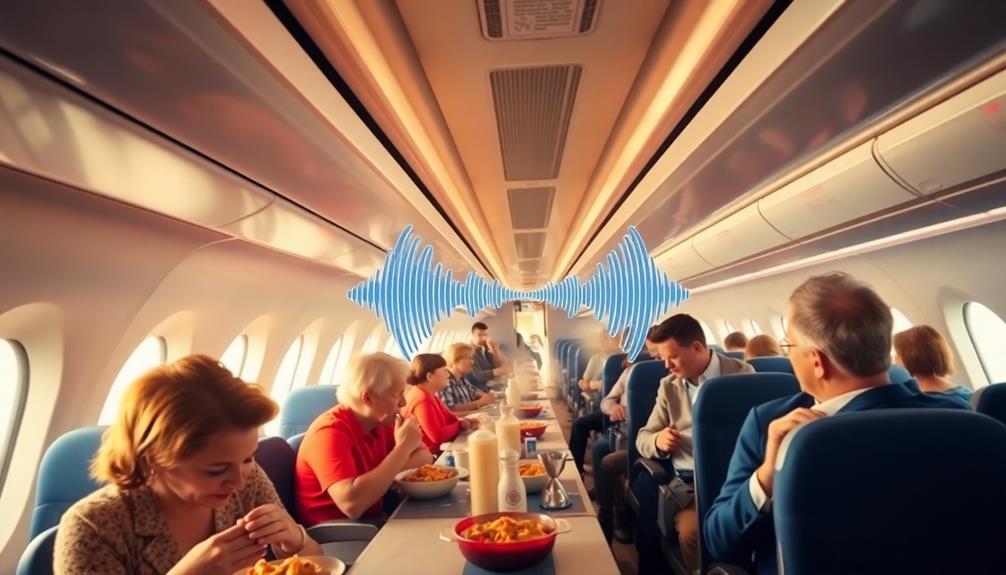
Air travel isn't just about altitude affecting your wine choices; noise levels in the cabin play a significant role in how you experience flavor.
In the loud environment of an airplane, you might notice that your perception of saltiness decreases and the sweetness drop can be quite pronounced. Research indicates that noise can diminish these taste sensitivities by about 30% at high altitudes.
Interestingly, the same conditions enhance umami-rich foods, making them more appealing during flights.
With the average noise level reaching up to 85 decibels, it's important to grasp how this affects your in-flight meal experience. Here are some key points to reflect on:
- Loud environments reduce sweetness and saltiness.
- Savory flavors, particularly umami, are enhanced in noisy settings.
- Airplane meals may need to focus on umami-rich options.
- Your taste buds react differently due to combined pressure and noise.
Next time you're flying, pay attention to how the noise impacts your meal. You might find that opting for savory dishes makes your dining experience much more enjoyable!
Frequently Asked Questions
Does Flying Affect Your Taste Buds?
Yes, flying affects your taste buds. At high altitudes, your sensitivity to sweet and salty flavors drops, making food taste bland. The dry air also reduces your sense of smell, further impacting your overall dining experience.
Does Altitude Affect Your Taste Buds?
Imagine eating a gourmet meal while holding your breath—hard, right? At altitude, your taste buds get similarly muted. The pressure drop and dryness dull your senses, making flavors less vibrant than they are on the ground.
What Things Can Affect Your Taste Buds?
Many factors affect your taste buds, like temperature, humidity, and even background noise. Illness can also alter your sense of taste, plus certain medications might change how you perceive flavors, impacting your overall eating experience.
Which Sense Is Affected During Air Travel?
During air travel, your sense of taste takes a toll. The dry, dynamic environment diminishes your ability to savor flavors, leaving meals less memorable and necessitating stronger seasonings to satisfy your palate's preferences.
Conclusion
So, next time you fly, remember: high altitude dulls your taste buds, noise alters your flavor perception, and the meals you enjoy are shaped by unique challenges. Whether it's the cutlery you use or the wine you sip, every detail plays a role in your dining experience. Embrace the innovations in in-flight cuisine and savor the journey. After all, it's not just about where you're going; it's about how you taste the adventure along the way.
